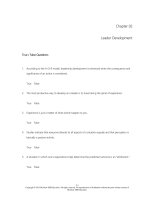Leadership enhancing the lessons of experience 8th by hughes curphy chap 01
Bạn đang xem bản rút gọn của tài liệu. Xem và tải ngay bản đầy đủ của tài liệu tại đây (488.5 KB, 27 trang )
Copyright © 2015 McGraw-Hill Education. All rights reserved. No reproduction or distribution without the prior written consent of McGraw-Hill Education.
1-1
Chapter
1
What Do We Mean by Leadership?
“Lives of great men all remind us we can
make our lives sublime and, departing,
leave behind us footprints on the sands of
time.”
~ Henry Wadsworth Longfellow
1-2
Profiles in Leadership
• Peter Jackson
– Film director, The Lord of the Rings Trilogy
• Howard Schultz
– Chairman and Chief Global Strategist of Starbucks
• Paul Revere
– American Revolutionary War Hero
• Aung San Suu Kyi
– Nobel Peace Prize Recipient
• Bill Gates
– Co-founder and Assistant Chairman to CEO of
Microsoft
1-3
What is Leadership?
• Leadership is a complex phenomenon involving
the leader, the followers, and the situation.
• Due to the complexity of leadership, leadership
researchers have defined the concept in many
different ways:
– The process by which an agent induces a subordinate
to behave in a desired manner.
– Directing and coordinating the work of group members.
– An interpersonal relation in which others comply
because they want to, not because they have to.
1-4
What is Leadership?
(continued)
– The process of influencing an organized group toward
accomplishing its goals.
– Actions that focus resources to create desirable
opportunities.
– Creating conditions for a team to be effective.
– The ability to get results and the ability to build teams;
these represent the what and the how of leadership.
– A complex form of social problem solving.
1-5
Leadership is Both a Science
and an Art
• Bass & Stogdill’s Handbook of Leadership: Theory,
Research and Managerial Applications cites
approximately 8,000 studies on leadership.
• Some managers may be effective leaders without ever
having taken a course or training program in leadership.
• Some scholars in the field of leadership may be
relatively poor leaders themselves.
• Leadership will always remain partly an art as well as a
science.
1-6
Leadership is Both Rational
and Emotional
• Leadership includes actions and influences
based on reason and logic as well as those
based on inspiration and passion.
• Since people are both rational and emotional,
leaders can use rational techniques and/or
emotional appeals.
1-7
Leadership is Both Rational
and Emotional (continued)
• Aroused feelings can be used either positively
or negatively, constructively or destructively.
• The mere presence of a group can cause
people to act differently than when they are
alone.
• Leaders need to consider both the rational and
the emotional consequences of their actions.
1-8
Leadership and Management
• Managers:
• Leaders:
administer
innovate
maintain
develop
control
inspire
have a short-term
view
have a long-term
view
ask how and when
imitate
accept the status
quo.
ask what and why
originate
challenge the
status quo
1-9
Leadership and Management
Overlap
1-10
Leadership Myths
Myth: Good Leadership is All Common
Sense
•
•
•
•
•
Most leadership literature only confirms
common sense knowledge.
Common sense is ambiguous.
The challenge is to know when common
sense applies and when it does not.
If leadership was simply common sense, then
workplace problems would be few, if any.
Effective leadership must be something more
than just common sense.
1-11
Leadership Myths
Myth: Leaders are Born, not Made
•
•
•
•
Many factors and formative experiences
influence behavior and leadership.
Research shows cognitive abilities and
personality traits are partially innate.
Different environments can nurture or
suppress different leadership qualities.
Leaders are born and made.
1-12
Leadership Myths
Myth:
The Only School You Learn Leadership from
Is the School of Hard Knocks
•
•
•
Formal study and experiential learning
compliment each other.
Students must learn to discern critical lessons
about leadership from their own experience.
Being able to analyze experiences from
multiple perspectives may be the greatest
contribution a formal course in leadership
can give you.
1-13
The Interactional Framework for
Analyzing Leadership
1-14
The Interactional Framework for
Analyzing Leadership
• The interactional framework depicts leadership
as a function of three elements:
– The leader
– The followers
– The situation
• A particular leadership situation scenario can be
examined using each level of analysis separately.
– Examining interactions in the area of overlaps can lead
to better understanding.
• Leadership is the result of complex interactions
among the leader, the followers, and the situation.
1-15
The Leader
• Individual aspects of the leadership equation:
– Unique personal history
– Interests
– Character traits
– Motivation
• Effective leaders differ from their followers and
from ineffective leaders on elements such as:
– Personality traits, cognitive abilities
– Skills, values
• Another way personality can affect leadership is
through temperament.
1-16
The Leader
(continued)
• How leadership status is reached is important.
• Leaders appointed by superiors may have less
credibility and may get less loyalty.
• Leaders elected or emerging by consensus from
ranks of followers are seen as more effective.
• A leader’s experience or history in a particular
organization is usually important to her or his
effectiveness.
• The extent of “follower participation” in a leader’s
selection may affect the leader’s legitimacy.
1-17
The Followers
• Both practitioners and scholars stress the
relatedness of leadership and followership.
• Aspects of followers that affect the leadership
process:
–
–
–
–
–
Expectations
Personality traits
Maturity levels
Levels of competence
Motivation
• Workers that share a leader’s goals and values
are more motivated.
• Other relevant variables include:
– The number of followers reporting to a leader
– Followers’ trust and confidence in the leader
1-18
The Followers (continued)
• The leader-follower relationship has undergone
dynamic change for many reasons:
– Increased pressure to function with reduced
resources
– Trend toward greater power sharing and
decentralized authority in organizations
– Increase in complex problems and rapid changes.
• Followers can become much more proactive in
their stance toward organizational problems.
• Followers can become better skilled at
“influencing upward” by being flexible and open
to opportunities.
1-19
The Situation
• Leadership often makes sense only in the
context of how the leader and followers
interact in a given situation.
• The situation may be the most
ambiguous aspect of the leadership
framework.
1-20
Illustrating the Interactional Framework:
Women in Leadership Roles
• Women are taking on leadership roles in
greater numbers than ever before.
• Problems still exist that constrain the
opportunity for capable women to rise to the
highest leadership roles in organizations.
• Research shows that there are no
statistically significant differences between
the leadership styles of men and women.
1-21
Illustrating the Interactional Framework:
Women in Leadership Roles (continued)
• Differences that were found:
– Women and men have different networking patterns.
– Compared to men, women’s trust in each other tends
to decrease when work situations become more
professionally risky.
– Women’s commitment to the organizations they
worked for was more guarded than that of their male
counterparts.
– Women were more likely to be willing to take career
risks by going to new areas of the company where
women had not been before.
1-22
Illustrating the Interactional Framework:
Women in Leadership Roles (continued)
• Research suggests that many women are
succeeding because of characteristics originally
considered too feminine for effective leadership.
• Women tend to use “interactive leadership”
based on enhancing others’ self-worth and
believing that the best performance occurs when
people have job satisfaction and feel good about
themselves.
• The interactive leadership style most likely
developed from women’s socialization
experiences and career paths.
1-23
Illustrating the Interactional Framework:
Women in Leadership Roles (continued)
• Four general factors explain the shift toward
more women in leadership roles:
–
–
–
–
Women themselves have changed.
Leadership roles have changed.
Organizational practices have changed.
Culture has changed.
• The glass cliff, a recently identified challenge
for women, indicates that female candidates for
an executive position are more likely to be hired
than equally qualified male candidates when an
organization’s performance is declining.
1-24
There is No Simple Recipe for
Effective Leadership
• Leadership must always be assessed in the
context of the leader, the followers, and the
situation:
– A leader may need to respond to various followers
differently in the same situation.
– A leader may need to respond to the same follower
differently in different situations.
– Followers may respond to various leaders quite
differently.
– Followers may respond to each other differently with
different leaders.
– Two leaders may have different perceptions of the same
followers or situations.
1-25









